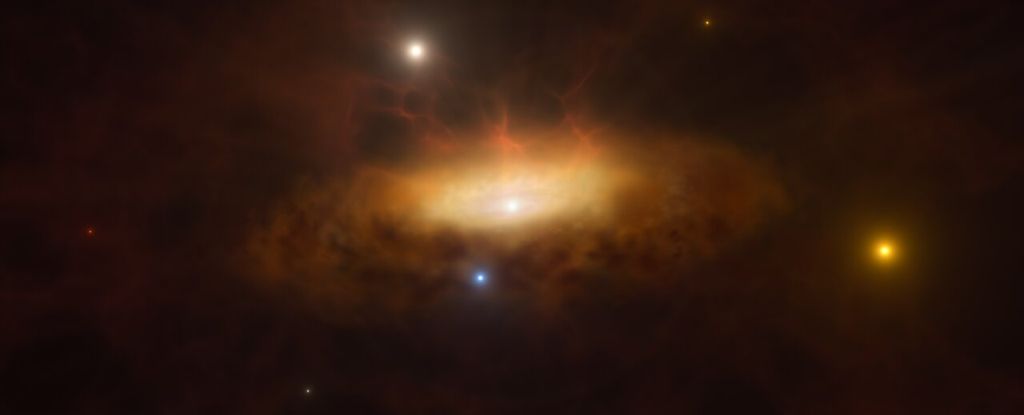In December 2019, astronomers were amazed when the core of a relatively calm galaxy 300 million light-years away suddenly lit up like a Christmas tree, glowing brighter than we’ve ever seen it before.
A giant black hole that went into action and started gobbling up material from the space around it is the best explanation for such a faint galaxy suddenly bursting with light. Other events, such as exploding stars, can cause a distant galaxy to light up – but these events usually fade over time.
SDSS1335+0728, as the galaxy is known, didn’t do the typical thing. In fact, it has become even brighter, shining in optical, infrared and ultraviolet light to this day. More recently, in February of this year, it even began to emit X-rays.
“The most tangible option to explain this phenomenon is that we see how [core] of the galaxy is beginning to show… activity,” says astronomer Lorena Hernández García of the Millennium Institute for Astrophysics (MAS) and the University of Valparaiso in Chile.
“If so, it would be the first time we’ve seen the activation of a massive black hole in real time.”
Black holes don’t just sit around in space and continuously burn. They can only access material that is within their gravitational range. If there is nothing nearby, they remain relatively quiet or motionless. The supermassive black hole at the center of the Milky Way, for example, is not classified as active because it feeds only minimally.
An active supermassive black hole, by contrast, is one that makes the space around it glow. The black hole itself does not glow, of course; but if there is enough matter around it to feed on furiously, the forces at work, such as friction and gravity, cause the material to heat up to the point that it blazes with light as it spirals inexorably toward the black hole.
Galaxies with varying levels of activity in their cores have been observed across vast regions of spacetime, informing models that suggest that ingesting large amounts of material is one of the mechanisms by which supermassive black holes grow to such colossal sizes.
Evidence also suggests that supermassive black holes can change their activity levels. The Milky Way, for example, has giant bubbles extending above and below the galactic plane from previous activity at the center. Other galaxies have similar characteristics.
But to see the transition from dormant to active is very special indeed.
We’ve seen black holes suddenly blaze with light before; this is usually what is known as a tidal disruption event, in which a passing star or other ball of matter is captured by a lurking black hole, producing a burst of light as it is torn apart and swallowed.
A comprehensive analysis of the change in light produced by SDSS1335+0728 and its 1.5 million solar mass black hole reveals that a tidal disruption event is not the most likely culprit; such events are also usually short-lived.
frameborder=”0″ allow=”accelerometer; automatic execution; clipboard-recording; encrypted media; gyroscope; picture in picture; web sharing” referrerpolicy=”strict-origin-when-cross-origin” allowfullscreen>
“In the case of SDSS1335+0728,” says astronomer Claudio Ricci of the University of Diego Portales in Chile, “we were able to observe the wake of the massive black hole, [which] suddenly began to feast on gas available in its surroundings, becoming very bright.”
Astronomers have seen other examples recently of what may be a supermassive black hole entering an active phase, but further observations are needed to determine whether the increase in brightness continues.
This means that SDSS1335+0728 may represent a blueprint for what such a transition looks like. Because we don’t know what triggers the supermassive black hole to turn back on, studying the galaxy can help astronomers develop models.
That, in turn, could reveal the likelihood of it happening elsewhere — including right here in our own galaxy, the Milky Way.
However, it is possible that the brightening of SDSS1335+0728 is the result of a very special type of tidal disturbance. Astronomers will continue to watch it closely to confirm what it’s doing and what this behavior might mean for our understanding of the universe.
The study was published in Astronomy and astrophysics.



